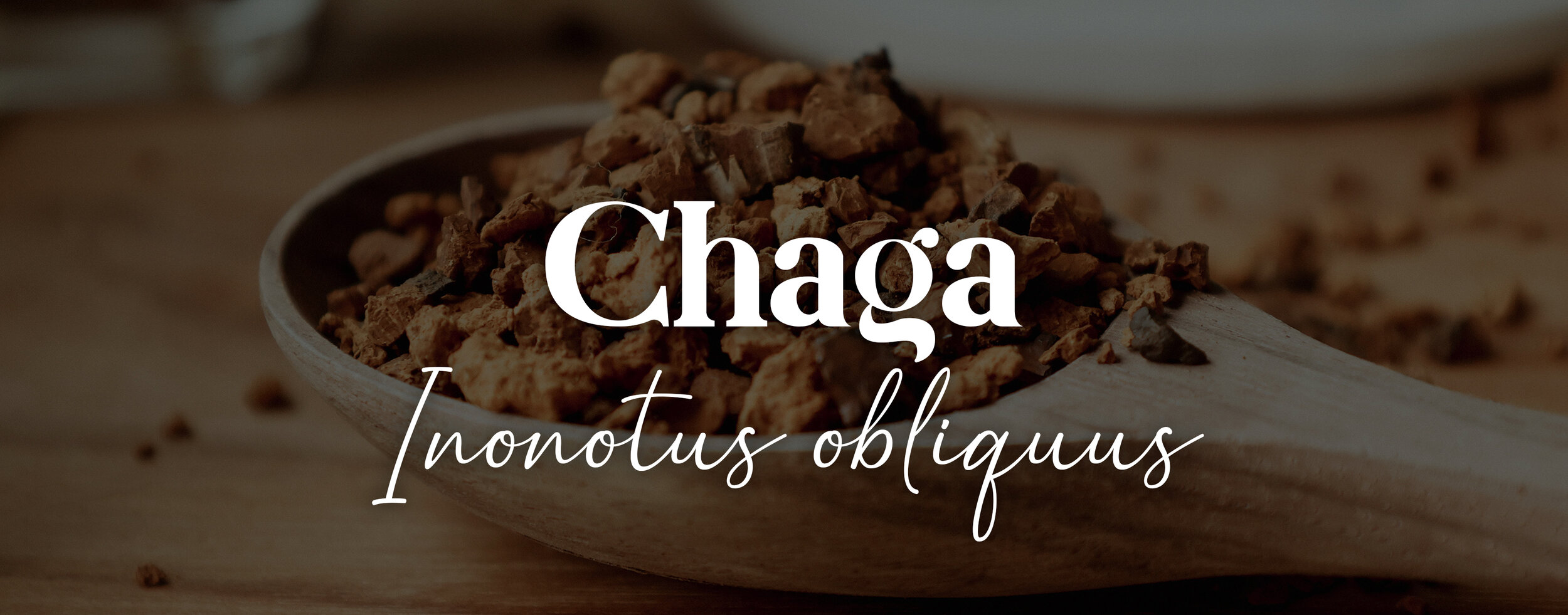Chaga Mushroom (Inonotus obliquus)
by Tania Byrne
Unique, mysterious and generous, Chaga is one of my favorite medicinal mushrooms to work with. Especially through Autumn and winter, I love adding this gentle yet powerfully supportive mushroom into my daily routine. The flavor is fairly neutral with a hint of woody vanilla that goes beautifully in a cup of chai tea or coffee. Let’s get to know Chaga!
Common Names: Chaga, Cinder conk, Black mass
Species: Inonotus obliquus
Kingdom: Fungi
Family: Hymenochaetaceae
Description: The visible mass (the sterile conk) is actually the mycelia (AKA Sclerotia). This has an irregular shape and it’s color goes from light brown/orange in the middle to a dark brown and black (due to melanin) towards the surface. The texture is like cork when fresh and wood bark when dry.
Habitat: Found most commonly on Birch trees (to which it is parasitic) as well as Alder, Beech and other hardwood trees in cold northern regions. Native habitats include Russia and the Northern regions of Europe, Asia and North America. Chaga slowly infects the tree (which lives 1-8 decades after infection) after settling in wounds such as after a branch breaks off.
Parts Utilized: Most commonly it’s the Sclerotia harvested from a tree, though the mycelia can also be cultivated in grain as well. Unlike other common mushrooms, the fruiting body is rarely seen and rarely, if ever, used. Because the fruiting event is rare, occurring within a host tree towards the end of its life, it’s details are still wrapped in mystery.
Energetics: Neutral, very slightly drying
Taste: Neutral with a mild woody, sweet and very slight astringent tones
Actions: Immunomodulating, Immune Tonic, Antiviral, Antiinflammatory, Tonic, Anti-Tumor, Anti-Cancer, Adaptogen, Stomachic
Well known constituents: Beta Glucans, polyphenols, polysaccharides, phenolic compounds, betulin, betulinic acid, triterpenoids
Sources: Organically grown, wild harvest (note: make sure to only get ethically wild harvested because popularity is increasing and the slow growing stands can become endangered!)
Medicinal Uses:
Seasonal Immune support
Excellent for use starting the beginning of Autumn (or slightly before) for those with weakened immunity and worked with consistently throughout winter (especially in Northern regions where Vitamin D is harder to get via sunlight and cold and flu seasons occur). Chaga supports the immune system without overstimulating it, which is where it’s immunomodulating benefit comes in. You do not want or need your immune system to be stimulated constantly, and this could potentially aggravate autoimmune conditions, but you may want to strengthen immune function up to a good level to keep healthy throughout winter. This intelligent ability of immunomodulating herbs to balance immune function, rather than have a blanket stimulating or suppressing action, is one of nature's gifts to us.
Cancer prevention, treatment & treatment support
Both historic and current use for a variety of cancer treatment exist in Russia, and there is a lot of modern research backing up these uses (though some studies point to only benefiting certains types of cancer, like stomach for example, and not other types).
In addition to working just with Chaga, there is also use as support during other conventional cancer treatments. One study on its anti tumor potential (source 1) : “for those who are in the process of chemotherapy administration of the fungus will not only chemosensitize the tumor cells and thereby increasing the chemotherapeutic effects, but also help to restore the compromised immunity and protect against ulcerative GI tract damage and other side-effects induced by chemotherapy.”
General, Stomach & Intestinal Health
Chaga has an extremely high level of antioxidants and is helpful to protect against oxidative stress, DNA damage, inflammation and offers a cardioprotective benefit from reduction in overall inflammation. The antiinflammatory benefit also makes its way to the stomach and lower gastrointestinal system, making it a great ally for those with digestive disorders such as ulcers, gastritis, IBS, Chrones and Irritable Bowel Disease in particular. There is also some benefit for metabolic disorders and blood sugar balance, however due to the potential of endangerment, it’s advised to work with more local and abundant herbs for general metabolic support.
Preparation and extraction:
Water extraction: Simmer for 20+ minutes to 2 hours. Chaga can be strained out and resimmered 2-4 times before it starts to lose color and potency ( ie. why I see Chaga as generous)
Alcohol extraction: In tincture making, it’s best to use a double extraction method with mushrooms, especially hard ones. There will be alcohol and water extraction done separately, then the liquid from both extractions will be combined. The two most popular methods are as follows: 1. Tincture Chaga in 95% alcohol for 2+ weeks. Strain, save and then decoct the Chaga in water for 30minutes - 2 hours. Strain and combine the liquid. Or 2. Decoct the chaga first, strain and save then tincture the Chaga in alcohol for 2+ weeks. Strain and combine liquids.
Powder can be added directly to decocting teas and soups (before or during cooking to enhance extraction with heat)
History of Use
Recorded use in Russian Folk Medicine since at least the 16th century for cancers, consumption, digestive disease and general pain. Still used in Russia for stomach and intestinal diseases. The name Chaga comes from the Russian word for fungus, which originates from the Komi-Permyak (the indiginous people) of the Siberian Kama River Basin.There is also historical and modern use in Scandinavia, NE Asia, Alaskan as well as some uses in Japan and even Tibet.
Folklore
A Finnish tale: “There was a legend about the first man who discovered Chaga in the forest. He was older than old, a long white beard that trailed before him & a long stretch of snow-white hair that followed behind him. He was so old that he was unable to stand up straight, though found himself in one of the beautiful Birch forests of Suomi where he stumbled upon the first Chaga. Upon drinking it, it was said that his hair turned pitch black & his youth was fully restored both physically & energetically.” Possibly a tale about the benefits of Chagas high antioxidant content?
My Experience
Enjoying a freshly brewed cup of Chaga tea feels like such a cozy experience. The relaxation is mild enough for me to wonder if it’s coming not only from the ritual of enjoying a warm cup of tea but also that this herb is a fairly rare and mysterious winter dwelling forest medicine here to help support me through my own winters? Either way, I used to be that person who caught all the colds in winter, but since working with Chaga (as well as other building immune adaptogen herbs) I am more confident in my body’s ability to hold its own in our long, wet & cold Pacific NW winters.
Other Interesting Information
Even though Chaga mycelium that is cultivated on grain has some betulinic acid, it is much higher when found on Birch trees. Since Birch trees also contain Betulinic acid, there may be a synergetic effect going on as the Chaga holds onto and somehow processes this compound to make it more bioavailable to us. This occurrence seems to play a significant role in Chagas cancer fighting magic.
Possible Contraindications
Oxalates: there seems to be a relatively high amount of oxalates in Chaga, which may cause contraindications to emerge in the future (especially for use with those with kidney disorders). It does seem though that the traditional method of simmering/boiling and straining the chaga, rather than consuming the powder whole, can significantly reduce the risk of ingesting excessive oxalates.
Immune Stimulation
Even though Chaga can beautifully balance the immune system, it can also have an immune stimulating effect as well which could potentially interfere with medications that purposefully suppress immune function.
Want more herbal goodness?
🌼Sign up for the HerbRally newsletter and receive these THIRTEEN herbal freebies!
VIDEO | Most Vital Herb in David Hoffmann’s First-Aid Kit
WEBINAR | Herbal First Aid with Heather Irvine
EBOOK | 86 Page Plant Healer Book
30 DAYS FREE | HerbRally Schoolhouse
EBOOK | Calendula for Radiant Skin by Rosalee de la Forêt
VIDEO | 5 Herbal Events Around the World presented by Bevin Clare
BOOK DISCOUNT | The Essential Guide to Western Botanical Medicine
PRIVATE COMMUNITY | HerbRally Facebook Group
BOOK EXCERPT | 36 Pages from Plant Healer's "Nourishing Foods" Book
DISCOUNT | 15% off all Mountain Rose Herbs products
DISCOUNT | Mushroom Revival
AUDIO | Hour-long Adaptogens Class with Heather Irvine
DISCOUNT | 10% off all HerbRally products
👉 CLAIM YOUR FREEBIES!
Mossy Tonic and Epic Herbalism was founded by Tania Byrne, a Portland area Herbalist with a passion for sustainability, health and learning about the beautiful plants in the Pacific NW region she grew up in.
Tania has more than a decade of botanical exploration under her belt and a background in Traditional Western Herbalism. She also hosts local herbs walks , classes and just released a new course about Holistic Health for clear skin!
>>Follow Tania Byrne on Instagram and visit her website to learn more.<<
Sources
“Deciphering the antitumoral potential of the bioactive metabolites from medicinal mushroom Inonotus obliquus” https://pubmed.ncbi.nlm.nih.gov/32877719/
Medicinal Mushrooms with Christopher Hobbs (lecture)
3. The Mycophile Volume 47:1 The Chaga Story by Ron Spinosa
4.“Bioactivity-based analysis and chemical characterization of cytotoxic constituents from Chaga mushroom (Inonotus obliquus) that induce apoptosis in human lung adenocarcinoma cells” https://www.sciencedirect.com/science/article/abs/pii/S037887411831403X
Vital Ways School - Notes taken
Inhibitory effects of a polysaccharide extract from the Chaga medicinal mushroom, Inonotus obliquus (higher Basidiomycetes), on the proliferation of human neurogliocytoma cells. Ning XB, Qi Luo Q, Li C, Ding ZY, Pang J, Zhao C. Int J Med Mushrooms. 2014;16(1):29–36.
Chaga mushroom extract inhibits oxidative DNA damage in human lymphocytes as assessed by comet assay. https://www.ncbi.nlm.nih.gov/pubmed/15630179
Savage GP, Nilzen V, Österberg K, Vanhanen L. 2001. “Soluble and insoluble oxalate content of mushrooms”. International Journal of Food Sciences and Nutrition 53: 293- 296.
Antiinflammatory and Immunomodulating Properties of Fungal Metabolites https://www.ncbi.nlm.nih.gov/pmc/articles/PMC1160565/




